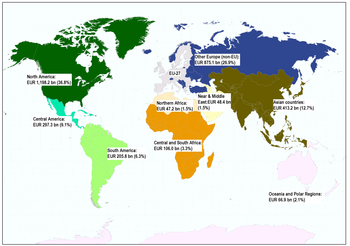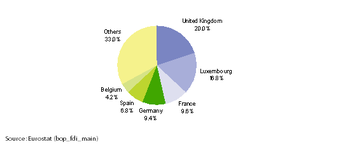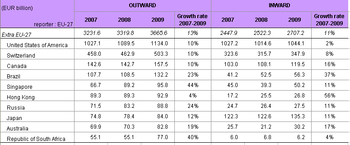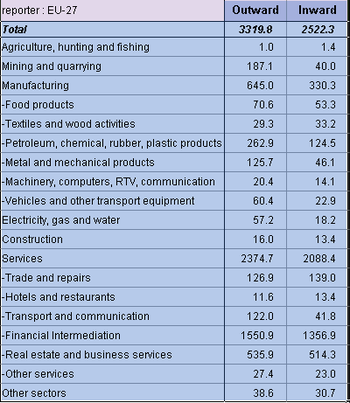Archive:Foreign direct investment statistics
- Data from October 2010, most recent data: Further Eurostat information, Main tables and Database.
Foreign direct investment (FDI) is the category of international investment made by an entity resident in one economy (direct investor) to acquire a lasting interest in an enterprise operating in another economy (direct investment enterprise). The lasting interest is deemed to exist if the direct investor acquires at least 10 % of the voting power of the direct investment enterprise.
File:FDI outward flows by main partner, 2009 (1) (EUR 1 000 million).png

(EUR 1 000 million) - Source: Eurostat (bop_q_eu) and (bop_q_c)

(EUR 1 000 million) - Source: Eurostat (bop_fdi_main)


(% of total EU-27 outward flows) - Source: Eurostat (bop_fdi_main)

(EUR 1 000 million) - Source: Eurostat (bop_fdi_pos)

(EUR 1 000 million) - Source: Eurostat (bop_fdi_pos)

FDI is a component of the balance of payments showing all financial transactions between one country or area – such as the European Union (EU) – and all other countries. This article discusses the developments for FDI in the EU, examining inward and outward flows, the origin and destination of these flows, important investment activities, as well as stocks of FDI at the end of the year.
Main statistical findings
Effects of the financial and economic crisis
Flows of FDI (new investments made during the reference period) fluctuate considerably from one year to the next, partly as a function of economic fortunes. FDI flows generally increase during times of rapid economic growth, while disinvestment is more likely during periods of recession as businesses focus on core activities in their domestic market.
EU Foreign Direct Investment (FDI) is still affected by the global financial and economic crisis. In 2010, EU outward flows decreased for the third consecutive year, down 62 % compared with 2009. At the same time, EU inward flows decreased by 75 %. Compared with the record peaks reached in 2007, outward flows have decreased five-fold and inward flows eight-fold.
In 2008, total FDI outflows dropped by 30 %, mainly due to the sharp decline in equity capital and reinvested earnings. A similar trend was observed in 2009, where all types of FDI flows contributed to the negative change.
Following the sharp decrease of 60 % in 2008, EU FDI inflows recovered in 2009 (26 %) thanks to the growth in equity capital and reinvested earnings.
The return from EU outward investments continued to decline in 2009, while the return from inward investments remained relatively stable.
The provisional figures for 2010 show a sharp drop in EU FDI, both outward and inward, confirming the continuous impact of the global economic turmoil. FDI flows channelled through special purpose entities (SPEs) have played a very significant role in the results for 2010.
The latest data for 2010 is presented in Figure 1 and Table 1.
Foreign direct investment by partner
EU FDI flows to and from main economic partners has been considerably affected by the global economic and financial crisis. In 2009, inward flows grew moderately (by 26 %), while outward flows shrank by 28 %. The decline in EU outflows was mostly because investment to the United States fell sharply — from EUR 148.2 billion in 2008 to EUR 79.2 billion in 2009. Meanwhile, US investment in the EU made a strong recovery, rising to EUR 97.3 billion, which is more than twice the 2008 figure (EUR 44.4 billion). Provisional figures for 2010 show a significant decrease in both flows.
Outward FDI into Canada dropped to disinvestment in 2009 and 2010. Incoming FDI from Canada, after decreasing by 14 % in 2009, seems to have recovered in 2010, rising to EUR 27.7 billion.
EU investment flows to emerging economies such as China have been less affected, with a moderate growth of 11 % in 2009 compared with the previous year. The preliminary results for 2010 also show a rebound in inward investment from
Asian countries, such as China (EUR 0.9 billion) and Hong Kong (EUR 11.3 billion).
EU outward flows to Brazil have been decreasing since 2007, but at a slower pace than with other main partners. Inward flows grew significantly in 2010 compared with 2009.
In Russia, EU outward investment dropped significantly in 2009 and even recorded disinvestment in 2010. Similarly, inward investments from Russia fell from the peak reached in 2007 (EUR 10.5 billion).
In the African region, EU investments in Egypt fell from EUR 10.6 billion in 2008, to EUR 2.1 billion in 2009. However, South Africa recorded a growth of 96 %, due to investments by special purpose entities (SPEs) based in Luxembourg.
Despite being affected by the crisis, the offshore financial centres play an important role in EU investments. In 2009, outward and inward flows significantly increased (by 127 % and 174 %, respectively). However, the provisional figures for 2010 show a deep drop and even disinvestment in the inward side.
EU's FDI main players for out going flows
FDI flows can oscillate considerably from one year to another, influenced mainly by large mergers and acquisitions. Luxembourg's share in EU FDI outward flows (24%) can be explained by the activities of Special Purpose Entities (SPEs), that represent about 85% of the total direct investment recorded in Luxembourg. In other EU Member States, especially the Netherlands and Hungary, SPEs likewise play an important role. However, the national data for these countries exclude SPEs here. In light of investments of this nature, Luxembourg showed a growth rate of 42% in 2009, compared to 2008, becoming the leading EU investor in extra-EU countries. Switzerland, the USA, Bermudas and the Bahamas were the four top destinations of FDI investments from Luxembourg revealing the importance of the financial sector. The United Kingdom recorded a strong drop of almost half of their investments towards extra-EU countries in 2009. There was also a movement towards weaken investments in traditional partners like the USA, Canada or Australia and invest more in other economies like United Arab Emirates, New Zealand, Japan and India.
Change in foreign direct investment positions (stocks)
EU outward and inward stocks (or positions) grew gradually in 2009: outward stocks grew by 10 % and inward stocks by 7 %. In 2008, both inward and outward stocks had increased by only 3 %. (see Table 2).
At the end of 2009, North America had the biggest share (35 %) of non-EU stocks. The United States accounted for about 31 % (EUR 1134.0 billion) of total EU outward stocks, and the growth rate (5 %) was the same as in 2008. The services sector represented 70 % of the EU stocks held in the United States, and most of those came from financial intermediation (39 %) and from real estate and other business activities (22 %). Manufacturing was also an important sector, accounting for 22 % of total EU stocks in the United States, and the main activity here was manufacturing of chemicals and chemical products. At the end of 2009, the main holder of EU FDI stocks in the US continued to be the United Kingdom, accounting for one quarter of them.
Switzerland was the second most important destination for EU FDI in 2009, accounting for 14 % of total stocks, and the main activity was financial intermediation. Canada was the third destination, with a 4 % share.
EU stocks in Russia grew by 24 % in 2007-2009. Financial intermediation and manufacturing were the main activities, and FDI stocks in these sectors were maintained.
In Asia, the main destinations for EU stocks were Singapore, Hong Kong and Japan, with China’s holdings continuing to grow in 2009 (11 % up on the 2008 figure). Malaysia, India and Indonesia recorded the fastest growth (82 %, 56 % and 22 %, respectively).
In Africa, the main destinations for EU stocks were South Africa (EUR 77 billion), Nigeria
(EUR 30.3 billion) and Egypt (EUR 26.4 billion). EU positions in South Africa grew by 40 % and this country became one of the EU’s top ten FDI partners.
In 2009, the United States provided 39 % of all inward investment in the EU. Its share was worth EUR 1044.1 billion at the end of that year. The US thus consolidates its position as the major EU stock investor, investing mostly in the services sector —which accounted for 79 % of all inward investment at the end of 2008.
Switzerland was the second biggest EU stock holder, with EUR 347.9 billion — 10 % more than in 2008. Other countries with significant shares of EU inward stocks were Japan, Canada and Brazil. Japan and Canada invested 10 % and 11 % more, respectively, in 2009 compared with the previous year. Brazil’s investment had also risen 7 % by the end of 2009 – though this is modest growth compared with the period 2006-2008, when Brazil tripled its stocks in the EU.
Foreign direct investment by activity
The structure of EU-27 FDI stocks by activity is shown in Table 3. Services provide by far the largest contribution both to outward (72 %) and to inward (83 %) stocks, and the share in 2008 was slightly greater than in 2007. Almost two thirds of services stocks were held in the financial intermediation sector.
The largest sectoral growth in EU-27 inward stocks was in air transport and in construction. The overall decline in foreign stocks held in manufacturing was compensated by the steady growth (5 %) in services, particularly due to an 8 % increase in the financial intermediation sector.
Income and rates of return
The financial crisis has had a persistent negative impact on the EU’s FDI income. Although slowing down, the decline continued in 2009, bringing the rates of return below even the record low levels reached in 2004.(see Figure 3). The EU’s investment income dropped by 13 %, while the income it paid to non-EU countries remained relatively unchanged at EUR 104.0 billion. The resulting net income from the rest of the world amounted to EUR 65.3 billion — 27 % less than in 2008. The EU’s FDI income balance in 2009 was only 0.55 % of its GDP, compared with 0.72 % in 2008.
Data sources and methodology
FDI statistics in the EU are collected according to Regulation (EC) No 184/2005 of the European Parliament and of the Council on Community statistics concerning balance of payments, international trade in services and foreign direct investment.
The methodological framework used is that of the OECD’s benchmark definition of foreign direct investment third edition, a detailed operational definition fully consistent with the IMF balance of payments manual, fifth edition.
Annual EU foreign direct investment statistics give a detailed presentation of FDI flows and stocks, showing which Member States invest in which partner countries and in which sectors. Eurostat collects FDI statistics for quarterly and annual flows, as well as for stocks at the end of the year. FDI stocks (assets and liabilities) are part of the international investment position of an economy at the end of the year.
Through outward FDI flows, an investor country builds up FDI assets abroad (outward FDI stocks). Correspondingly, inward FDI flows cumulate into liabilities towards foreign investors (inward FDI stocks). However, changes in FDI stocks differ from FDI flows because of the impact of revaluation (changes in prices and, for outward stocks, exchange rates) and other adjustments such as catastrophic losses, cancellation of loans, reclassification of existing assets or liabilities.
FDI flows are components of the financial account of the balance of payments, while FDI assets and liabilities are components of the international investment position. FDI income consists of the income accruing to the direct investor from its affiliates abroad. Income earned from outward FDI is recorded among credits in the current account of the balance of payments, while income paid to foreign owners of inward FDI stocks is recorded among debits.
FDI flows and positions are recorded according to the immediate host/investing country criterion. The economic activity for both flows abroad and flows in the reporting economy are classified according to the economic activity of the resident enterprise; the same applies to FDI positions.
FDI flows are new investments made during the reference period, whereas FDI stocks provide information on the position, in terms of value, of all previous investments at the end of the reference period. The intensity of FDI can be measured by averaging the value of inward and outward flows during a particular reference period and expressing this in relation to GDP.
The sign convention adopted for the data shown in this article, for both flows and stocks, is that investment is always recorded with a positive sign, and a disinvestment with a negative sign.
European aggregates (such as EU-27) include special purpose entities (SPEs), which are a particular class of enterprises (often empty shells or holding companies) not included in all countries' national statistics. Therefore, these aggregates are not simply the addition of national figures.
Context
In a world of increasing globalisation, where political, economic and technological barriers are rapidly disappearing, the ability of a country to participate in global activity is an important indicator of its performance and competitiveness.
In order to remain competitive, modern-day business relationships extend well beyond the traditional foreign exchange of goods and services, as witnessed by the increasing reliance of enterprises on mergers, partnerships, joint ventures, licensing agreements, and other forms of business co-operation.
FDI may be seen as an alternative economic strategy, adopted by those enterprises that invest to establish a new plant/office, or alternatively, purchase existing assets of a foreign enterprise. These enterprises seek to complement or substitute external trade, by producing (and often selling) goods and services in countries other than where the enterprise was first established.
There are two kinds of FDI, namely the creation of productive assets by foreigners or the purchase of existing assets by foreigners (acquisitions, mergers, takeovers, etc.). FDI differs from portfolio investments because it is made with the purpose of having control or an effective voice in management and a lasting interest in the enterprise. Direct investment not only includes the initial acquisition of equity capital, but also subsequent capital transactions between the foreign investor and domestic and affiliated enterprises.
Conventional trade is less important for services than for goods. While trade in services has been growing, the share of services in total intra-EU trade has changed little during the last decade. However, FDI is expanding more rapidly for services than for goods, increasing at a more rapid pace than conventional trade in services. As a result, the share of services in total FDI flows and positions has increased substantially, with services within the EU-27 becoming increasingly international.
Further Eurostat information
Publications
Main tables
- European Union direct investments (t_bop_fdi)
Database
- European Union direct investments (bop_fdi)
Methodology / Metadata
- European Union direct investments (ESMS metadata file - bop_fdi_esms)
Other information
Source data for tables, figures and map (MS Excel)
External links
- OECD Benchmark Definition of Foreign Direct Investment
- United Nations Conference on Trade and Development (UNCTAD) - FDI Statistics
